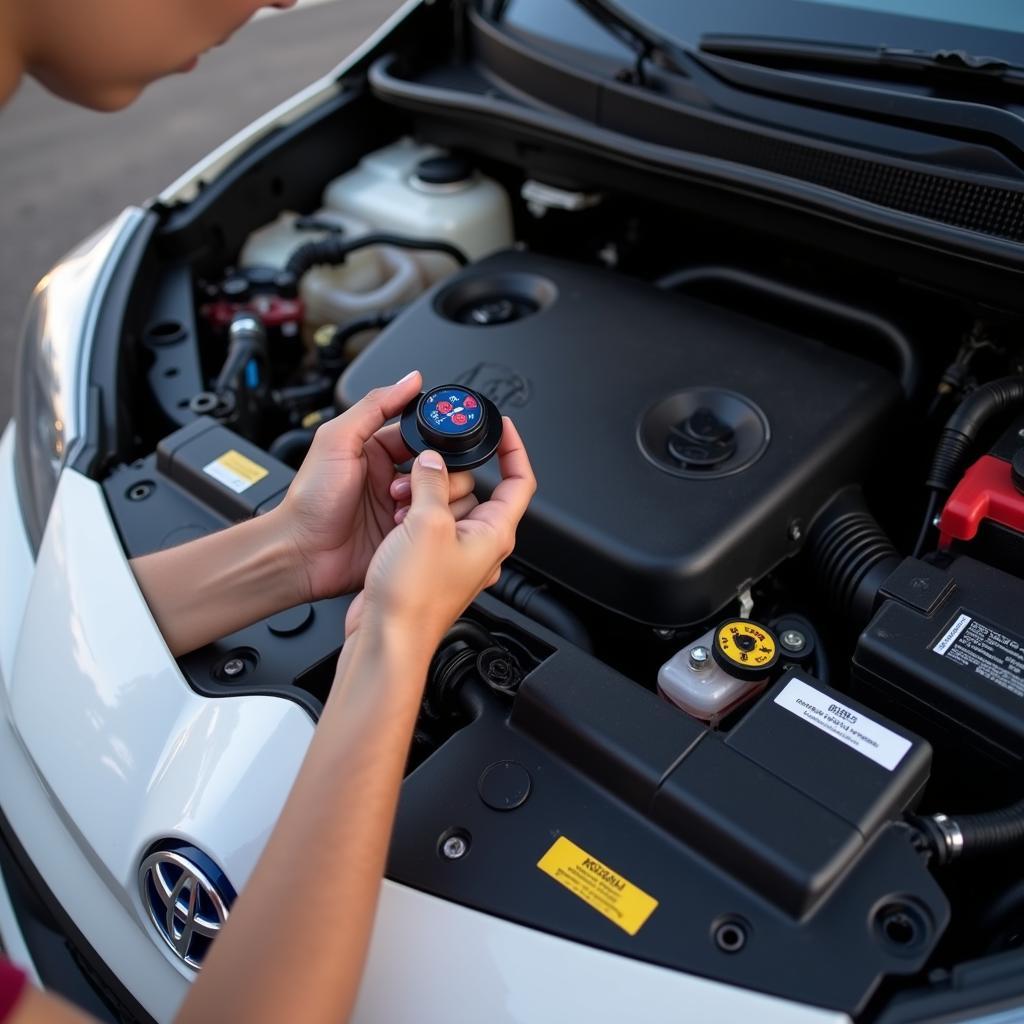A yellow brake system warning light on your Toyota Prius might be unsettling. It signals a potential issue with your braking system, demanding immediate attention. While not always indicating a critical problem, understanding its meaning and taking appropriate steps is crucial for your safety on the road.
What the Yellow Brake System Warning Light on Your Prius Means
The yellow brake system warning light, unlike the red brake warning light, doesn’t necessarily mean a complete brake failure is imminent. However, it does indicate that a component within the braking system requires attention.
Here’s what might trigger the yellow brake system warning light on your Prius:
- Low Brake Fluid Level: This is the most common culprit. Your Prius uses hydraulic fluid to power the brakes, and a leak or worn brake pads can lead to low fluid levels.
- Faulty Brake Light Switch: The brake light switch activates your brake lights when you press the pedal. If it malfunctions, it can illuminate the brake system warning light.
- Problem with the Anti-lock Braking System (ABS): Your Prius’s ABS helps prevent wheel lockup during hard braking. A malfunctioning ABS system, often due to a faulty sensor, can trigger the warning light.
- Issue with the Electronic Brake-force Distribution (EBD) System: The EBD works in conjunction with the ABS to distribute braking force optimally between wheels. A problem with this system can also turn on the warning light.
What to Do When the Yellow Brake System Warning Light Comes On
Seeing the yellow brake system warning light illuminated on your dashboard can be concerning, but it’s crucial to remain calm and take the following steps:
- Safely Pull Over: Find a safe location to park your Prius away from traffic.
- Check Your Brake Fluid Level: This is the first thing to inspect. Refer to your owner’s manual for the location of the brake fluid reservoir and instructions on how to check the fluid level. If it’s low, adding brake fluid might temporarily solve the issue, but it’s crucial to get your car inspected for leaks.
- Inspect Your Brake Lights: Have someone press the brake pedal while you check if all brake lights are functioning correctly. A faulty brake light switch might be the reason for both malfunctioning lights and the warning light.
- Avoid Driving (If Possible): If you suspect a leak or a more serious issue, it’s best to avoid driving your Prius and have it towed to a trusted mechanic or dealership.
 Checking the brake fluid level in a Toyota Prius
Checking the brake fluid level in a Toyota Prius
Diagnosing and Fixing the Problem
While visually checking your brake fluid and lights can provide some clues, pinpointing the exact cause of the yellow brake system warning light often requires a professional diagnosis.
Here’s how a mechanic or dealership will typically address the issue:
- Read the Diagnostic Trouble Codes (DTCs): Using a specialized scanner, they can read the error codes stored in your Prius’s computer, which will give them specific information about the problem.
- Inspect the Braking System: They will physically inspect the brake lines, hoses, calipers, and pads for any signs of leaks, wear, or damage.
- Test the ABS and EBD Systems: Mechanics have tools to test the functionality of these electronic systems and identify any faulty sensors or components.
- Repair or Replace Faulty Parts: Once the issue is identified, they will repair or replace the problematic part(s) to restore your Prius’s braking system to its optimal working condition.
 Mechanic inspecting the braking system of a Toyota Prius
Mechanic inspecting the braking system of a Toyota Prius
Remote Diagnostics and Software Solutions
In some cases, especially for issues related to the ABS or EBD, the problem might be resolved with software updates or recalibrations. This is where remote diagnostics and software solutions come in.
Services like those offered by specialized automotive technicians can provide:
- Remote Scanning and Diagnosis: By connecting to your Prius remotely, they can read the error codes and analyze data from your vehicle’s systems, offering a preliminary diagnosis without a physical visit.
- Software Updates and Programming: If the problem is software-related, they can often install the necessary updates or reprogram certain modules remotely, potentially saving you a trip to the mechanic.
However, it’s important to note that not all brake system issues can be fixed remotely. Problems like brake fluid leaks or worn brake pads require physical repair.
Preventing Future Brake System Warnings
Taking proactive measures can help prevent future brake system warning lights and ensure the longevity of your Prius’s braking system:
- Regular Brake Fluid Checks: Get into the habit of checking your brake fluid level at least once a month. This simple check can help you detect leaks early on.
- Timely Brake Pad Replacements: Don’t ignore the signs of worn brake pads, such as squeaking or grinding noises. Replacing them on time prevents damage to rotors and other brake components.
- Scheduled Brake System Inspections: Adhere to the recommended maintenance schedule in your owner’s manual for brake system inspections. This allows mechanics to catch potential issues before they escalate.
Conclusion
A yellow brake system warning light in your Toyota Prius should never be ignored. By understanding its potential causes and taking prompt action, you can address the issue effectively and ensure your safety on the road. Remember, regular maintenance and timely repairs are crucial to keeping your Prius’s braking system in peak condition. If you’re ever unsure about a warning light or your car’s behavior, don’t hesitate to consult with a qualified mechanic or your dealership for expert advice and assistance.
Frequently Asked Questions
1. Can I drive my Prius with the yellow brake system warning light on?
It’s not recommended. While you might not experience immediate braking failure, driving with a potential issue can worsen the problem and compromise your safety.
2. Is the yellow brake light different from the red brake light?
Yes, the red brake light typically signals a more critical problem, like a complete loss of brake fluid pressure, requiring immediate action.
3. How much does it cost to fix a yellow brake system warning light issue?
The cost varies depending on the underlying cause. A simple brake fluid top-up might cost a few dollars, while repairs related to the ABS or EBD system can be more expensive.
4. Can I fix the brake system warning light issue myself?
While you can check your brake fluid and brake lights yourself, it’s recommended to have a professional diagnose and repair any issues related to the braking system.
5. How often should I get my Prius’s brakes checked?
It’s best to follow the maintenance schedule in your owner’s manual, but a general guideline is to have your brakes inspected at least once a year or every 12,000 miles.
